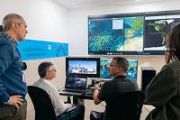
Copernical Team
Fugro supports debut of Lunar Terrain Vehicle prototype
 Earlier this year, Fugro Australia's Space Automation, AI, and Robotics Control Complex (SpAARC) entered into a partnership with U.S. space exploration company Intuitive Machines to aid their phase 1 feasibility contract with NASA for a Lunar Terrain Vehicle (LTV). On Friday, JSC's Space Centre Houston, hosted the unveiling of the first prototype, named Moon RACER.
Fugro, known for its exp
Earlier this year, Fugro Australia's Space Automation, AI, and Robotics Control Complex (SpAARC) entered into a partnership with U.S. space exploration company Intuitive Machines to aid their phase 1 feasibility contract with NASA for a Lunar Terrain Vehicle (LTV). On Friday, JSC's Space Centre Houston, hosted the unveiling of the first prototype, named Moon RACER.
Fugro, known for its exp GMV completes FASTNAV project advancing lunar rover capabilities
 GMV, a multinational technology company, has concluded the FASTNAV (Multi-range Navigation for Fast Moon Rovers) project, showcasing a navigation system that enables rovers to reach speeds of 1 m/s-unprecedented for autonomous vehicles on planetary surfaces. Funded by the European Space Agency (ESA) under its General Support Technology Program (GSTP) and supported by the UK Space Agency (UKSA),
GMV, a multinational technology company, has concluded the FASTNAV (Multi-range Navigation for Fast Moon Rovers) project, showcasing a navigation system that enables rovers to reach speeds of 1 m/s-unprecedented for autonomous vehicles on planetary surfaces. Funded by the European Space Agency (ESA) under its General Support Technology Program (GSTP) and supported by the UK Space Agency (UKSA), NASA SpaceX Crew-8 astronauts to speak publicly for first time since return
 The three NASA astronauts that were part of the SpaceX Crew-8 aboard Crew Dragon Endeavour will speak publicly today for the first time since their mission returned to earth late last month.
Astronauts Michael Barratt, Matthew Dominick, and Jeanette Epps will speak and take questions at a news conference at NASA's Johnson Space Center in Houston, Texas, starting at 3:15 p.m. EST, the ag
The three NASA astronauts that were part of the SpaceX Crew-8 aboard Crew Dragon Endeavour will speak publicly today for the first time since their mission returned to earth late last month.
Astronauts Michael Barratt, Matthew Dominick, and Jeanette Epps will speak and take questions at a news conference at NASA's Johnson Space Center in Houston, Texas, starting at 3:15 p.m. EST, the ag Dragon executes first successful reboost for Space Station
 NASA and SpaceX observed a significant milestone as SpaceX's Dragon spacecraft successfully demonstrated its ability to reboost the International Space Station's orbit on Friday at 12:50 p.m. EST. Using its Draco thrusters, the spacecraft adjusted the station's altitude, raising it by 7/100 of a mile at apogee and 7/10 of a mile at perigee over a 12-minute and 30-second operation.
This suc
NASA and SpaceX observed a significant milestone as SpaceX's Dragon spacecraft successfully demonstrated its ability to reboost the International Space Station's orbit on Friday at 12:50 p.m. EST. Using its Draco thrusters, the spacecraft adjusted the station's altitude, raising it by 7/100 of a mile at apogee and 7/10 of a mile at perigee over a 12-minute and 30-second operation.
This suc Hera initiates journey to mars with key deep-space burn
 ESA's Hera mission has completed its first major trajectory correction since its October 7 launch, positioning it for a vital Mars gravity assist scheduled for March 2025.
On October 23, Hera's trio of orbital control thrusters operated for 100 minutes, altering its speed by roughly 146 m/s. A secondary 13-minute burn on November 6 added an estimated 20 m/s, ensuring the spacecraft stays o
ESA's Hera mission has completed its first major trajectory correction since its October 7 launch, positioning it for a vital Mars gravity assist scheduled for March 2025.
On October 23, Hera's trio of orbital control thrusters operated for 100 minutes, altering its speed by roughly 146 m/s. A secondary 13-minute burn on November 6 added an estimated 20 m/s, ensuring the spacecraft stays o Ariane 6 set for first commercial flight in early 2025
 ArianeGroup, Arianespace, and their partners are gearing up for the second flight of the Ariane 6 launcher, following its successful inaugural launch on July 9. The upcoming mission marks the launcher's transition into commercial service.
Key milestones in preparation for this flight include:
+ The comprehensive analysis of data from the initial flight is complete, affirming Ariane 6
ArianeGroup, Arianespace, and their partners are gearing up for the second flight of the Ariane 6 launcher, following its successful inaugural launch on July 9. The upcoming mission marks the launcher's transition into commercial service.
Key milestones in preparation for this flight include:
+ The comprehensive analysis of data from the initial flight is complete, affirming Ariane 6 NASA astronauts won't say which one of them got sick after almost eight months in space
This request seems a bit unusual, so we need to confirm that you're human. Please press and hold the button until it turns completely green. Thank you for your cooperation!
Press and hold the button
If you believe this is an error, please contact our support team.
185.132.36.159 : 31862242-4c9d-4f99-8c40-eb26dcef
After two scrubs, SpaceX knocks out Cape Canaveral launch
This request seems a bit unusual, so we need to confirm that you're human. Please press and hold the button until it turns completely green. Thank you for your cooperation!
Press and hold the button
If you believe this is an error, please contact our support team.
185.132.36.159 : e148cd4a-f6fe-49c9-bf1c-78ecdcc8
Week in images: 04-08 November 2024

Week in images: 04-08 November 2024
Discover our week through the lens
Scientists harvest nutrient-rich rice grown in space
 At a crop breeding center in Shanghai, researchers have successfully harvested rice that was cultivated from seeds initially grown on China's space station Tiangong, also known as "Heavenly Palace." The rice plants have completed a full growth cycle on Earth, maturing after more than 100 days since planting.
This space-to-ground experiment began with six rice seeds sent into orbit in 2022
At a crop breeding center in Shanghai, researchers have successfully harvested rice that was cultivated from seeds initially grown on China's space station Tiangong, also known as "Heavenly Palace." The rice plants have completed a full growth cycle on Earth, maturing after more than 100 days since planting.
This space-to-ground experiment began with six rice seeds sent into orbit in 2022 



































